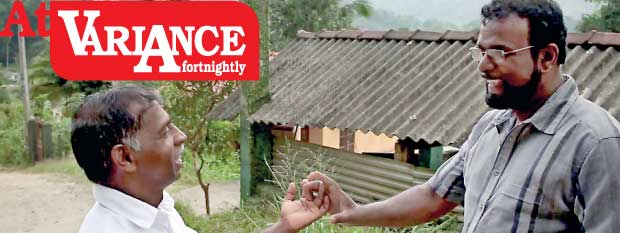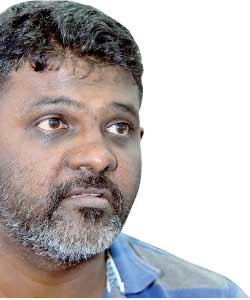Reply To:
Name - Reply Comment
Last Updated : 2024-04-19 00:03:00
 A scene from “Demons in Paradise”
A scene from “Demons in Paradise”
 Last week I saw the most honest, courageous and important piece of art --and certainly movie-- on Sri Lanka done by a Sri Lankan. Directed by Jude Ratnam, it is called “Demons in Paradise” and has already been screened at Cannes. It is about us, all of us. “Demons in Paradise” is a road movie, but it is unlike most road movies. While it has many roads, it is also a “reverse road movie” if I may coin a phrase, in that it takes the road back to the 1980s. It is a road movie that leads not only to a truth or truths about others or ourselves as a collective, but about the director himself. It ventures into the consciousness of a young man in the Tamil diaspora and the processing of his experience of what and where he’s coming from. He is not the man he was when the movie and the journey, end. He questions not only us, but himself and does so transparently, sharing the answers and the questions with his audiences.
Last week I saw the most honest, courageous and important piece of art --and certainly movie-- on Sri Lanka done by a Sri Lankan. Directed by Jude Ratnam, it is called “Demons in Paradise” and has already been screened at Cannes. It is about us, all of us. “Demons in Paradise” is a road movie, but it is unlike most road movies. While it has many roads, it is also a “reverse road movie” if I may coin a phrase, in that it takes the road back to the 1980s. It is a road movie that leads not only to a truth or truths about others or ourselves as a collective, but about the director himself. It ventures into the consciousness of a young man in the Tamil diaspora and the processing of his experience of what and where he’s coming from. He is not the man he was when the movie and the journey, end. He questions not only us, but himself and does so transparently, sharing the answers and the questions with his audiences.
At one level, this movie reports from the Conradian heart of darkness of Sri Lanka, evoking “the horror, the horror”, but when the film reaches the heart of darkness we see ourselves, our true selves, the truth of our times and situations—rather like the turn, the surprising inversion of the masterly closing sequence of Kubrick’s ‘2001’ or Tarkovsky’s ‘Solaris’, or at a much lesser level of artistic endeavour, of ‘The Omega Man’ ( “Soylent Green is people!”) and the original ‘Planet of the Apes’ (both with Charlton Heston). This is cinema from the abyss and back. Ratnam looks into the abyss and more importantly, catches on camera, former participants looking into the abyss. Still more significant, he makes us look into the abyss within us, as individuals, as distinct collectives and as an island society, a country. It upends simplistic narratives which endow communities with a monopoly of virtue and/or victimhood. It burns a hole in zero-sum paradigms that block the truth coming through. This movie, especially if subtitled in Sinhala and Tamil, can be the beginnings of a collective catharsis and can draw us together, begin the healing.
This film takes the lid off fanaticism, violent fundamentalism; of political evil—of the evil that human beings do to each other, including to non-participating innocents, in the name of political, ethnic or ethno religious causes. At its core, the movie confronts the question of right and wrong; of good and bad. It therefore deals with a universal moral theme and has a truly universal significance. The Bible says “know ye the truth and the truth shall set ye free”. Jude Ratnam’s movie not just tells the truth about us, it enables us to see the truth about our communities, our times and ourselves. By searching for the truth, by bringing the truth to light and letting the world see, by telling the truth to the people, Jude Ratnam has become an exceptional man; probably the freest young man I know—a maker of a truly existentialist film. If this movie is seen and understood, then the whole Tamil community can begin to be free. It is one of the most important movies I have seen and should be screened the world over, because the moral phenomenon it speaks to—the character of violent conflict and the indiscriminate use of that violence; the phenomenon of barbarism—is of truly global significance; a warning about moral boundaries valid anywhere people feel oppressed and fight for freedom. It reports from the Sri Lankan heart of darkness, which is also ‘the dark side of the Force’ of many but not all liberation struggles. If it is shown with suitable subtitling, say in Hebrew and Arabic, in Spanish and Tagalog, it can have a positive ripple effect in the collective consciousness of those societies.
Based on my experience in Sri Lanka as an observer-participant of serial civil wars, and my experience in countries which have experienced civil wars, I have always felt that authentic accountability and reconciliation can come, not from Geneva resolutions or lacerating top-down, state-driven domestic processes, but through art. This movie proves it, because as we have known from the time of Aristotle’s writing, good dramatic art produces catharsis and catharsis comes only from good dramatic art. There is a climactic scene of a conversation around a campfire, which can do more for accountability and reconciliation than a dozen co-sponsored resolutions of the UN Human Rights Council.
 Ratnam goes beyond and beneath the state, tracking the roots of evil even in the anti-state space, ultimately locating them in societies and individuals. It is not merely, or even primarily, the state that is held accountable. It is organized groups of humans and society itself. Ratnam does not ‘statize’ accountability; he socializes it. Accountability is no longer state-centric; it is ‘humano-centric’. Accountability and reconciliation are no longer top-down, formal, institutional and dis-organic; they are bottom-up, informal, social and organic processes. They are no longer unilaterally targeted, they are dialogic. They are no longer externalized (The Other and/or the State), they are internalized. They are not a one-way street, but a two-way, or better still, a multilateral, roundtable conversation. They do not take the form of a Special Court but of a conversation around a campfire.
Ratnam goes beyond and beneath the state, tracking the roots of evil even in the anti-state space, ultimately locating them in societies and individuals. It is not merely, or even primarily, the state that is held accountable. It is organized groups of humans and society itself. Ratnam does not ‘statize’ accountability; he socializes it. Accountability is no longer state-centric; it is ‘humano-centric’. Accountability and reconciliation are no longer top-down, formal, institutional and dis-organic; they are bottom-up, informal, social and organic processes. They are no longer unilaterally targeted, they are dialogic. They are no longer externalized (The Other and/or the State), they are internalized. They are not a one-way street, but a two-way, or better still, a multilateral, roundtable conversation. They do not take the form of a Special Court but of a conversation around a campfire.
As an indicted veteran of the decade that Jude Ratnam’s movie deals with, I can see the darkness gather. In 1980 the student movement mobilized against two initiatives of the UNP government. The current Prime Minister was involved with both as in the anti-student crackdown; the White Paper and the Private Medical College (PMC). The powerful Jayewardene administration was finally constrained to ‘nationalize’ the PMC, but not before the student movement had been radicalized. Today, a far weaker UNP is trying to avoid SAITM’s nationalization!
Bright young medical students were brutally baton charged by the STF when they occupied the Ministry of Health. Certainly the buildings had to be cleared and order restored, but tear gas alone would have done the trick. Instead, a Police paramilitary militia trained for counterinsurgency, stormed the building and baton-charged the students, even those running away. In the aftermath, the Minister of Health lied about Lenin to accuse the students of “terrorism”. Anyway, if these students were engaging in acts of terrorism, they must have been the world’s very first unarmed terrorists!
Bright young medical students were brutally baton charged by the STF when they occupied the Ministry of Health. Certainly the buildings had to be cleared and order restored, but tear gas alone would have done the trick
Meanwhile back at the walauwa, Chandrika, star of ‘The Mummy of Reconciliation Returns’, antagonizes the powerful Buddhist clergy --note the Kotte Sanghasabawa statement, signed by the respected pro-UNP senior monk Ven. Ittapane Dhammalankara! On TV news Sumanthiran confirms that the Interim Report of the draft Constitution fulfils the two fundamental requirements of federalism though the term itself isn’t used. He is quoted in the Sunday Observer saying “The new constitution will be based on the federal system although it will not be indicated in such terms”. Ranil and CBK publicly push for the Constitutional change which will federally empower a Northern PC which has just inducted “Jayalalitha Jr.”, pro-LTTE Ananthy Sasitharan as a Minister, placing her on track to be elected the next Chief Minister.
Champika Ranawake’s longstanding connection with Ven. Gnanasara emerges as Gammanpila blows the whistle on TV; this is the UNP’s Cyril Mathew Mk II option. Rajitha Senaratne accuses the Frontline Socialists of conspiring to launch an armed struggle. Sagala Ratnayaka fingers the FSP/IUSF. This is how the UNP framed the JVP after Black July ’83, which the left had nothing to do with, but sections of the UNP did (at least in the long run-up). The electoral safety-valves have not reopened. This was how we journeyed to the heart of darkness. The demons may reawaken in paradise.
PIC BY KITHSIRI DE MEL

Add comment
Comments will be edited (grammar, spelling and slang) and authorized at the discretion of Daily Mirror online. The website also has the right not to publish selected comments.
Reply To:
Name - Reply Comment
On March 26, a couple arriving from Thailand was arrested with 88 live animal
According to villagers from Naula-Moragolla out of 105 families 80 can afford
Is the situation in Sri Lanka so grim that locals harbour hope that they coul
A recent post on social media revealed that three purple-faced langurs near t

10 Apr 2024
09 Apr 2024